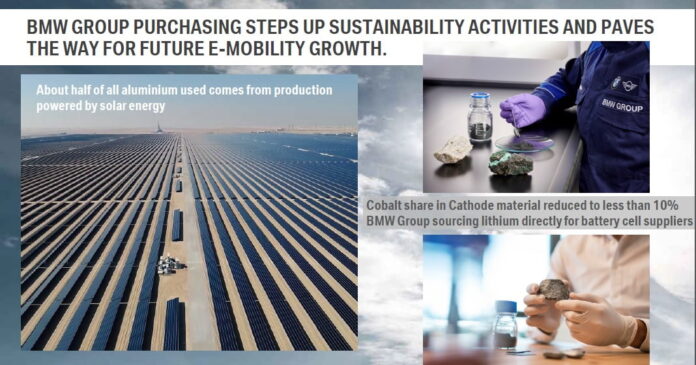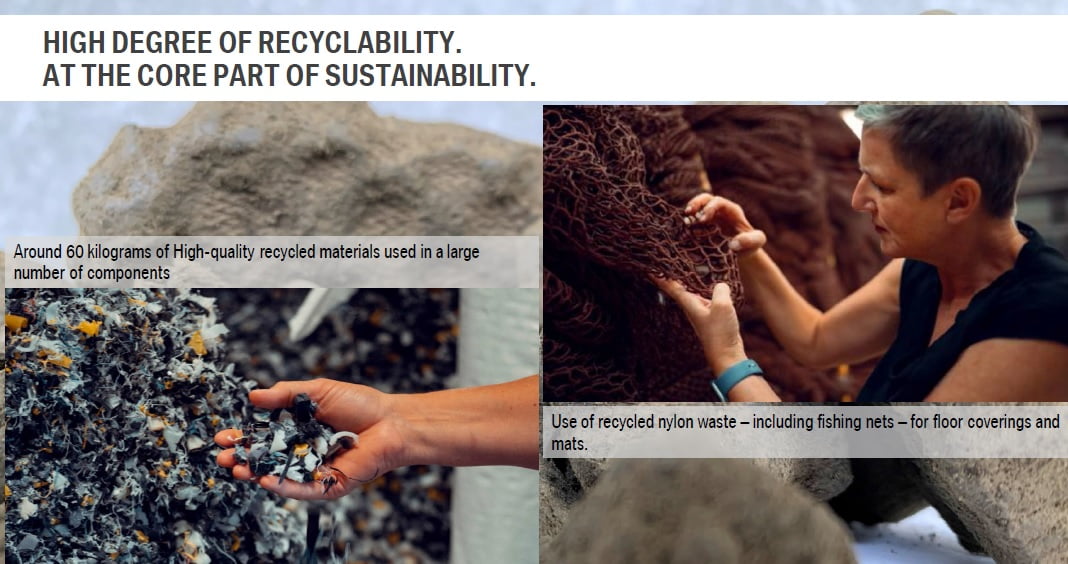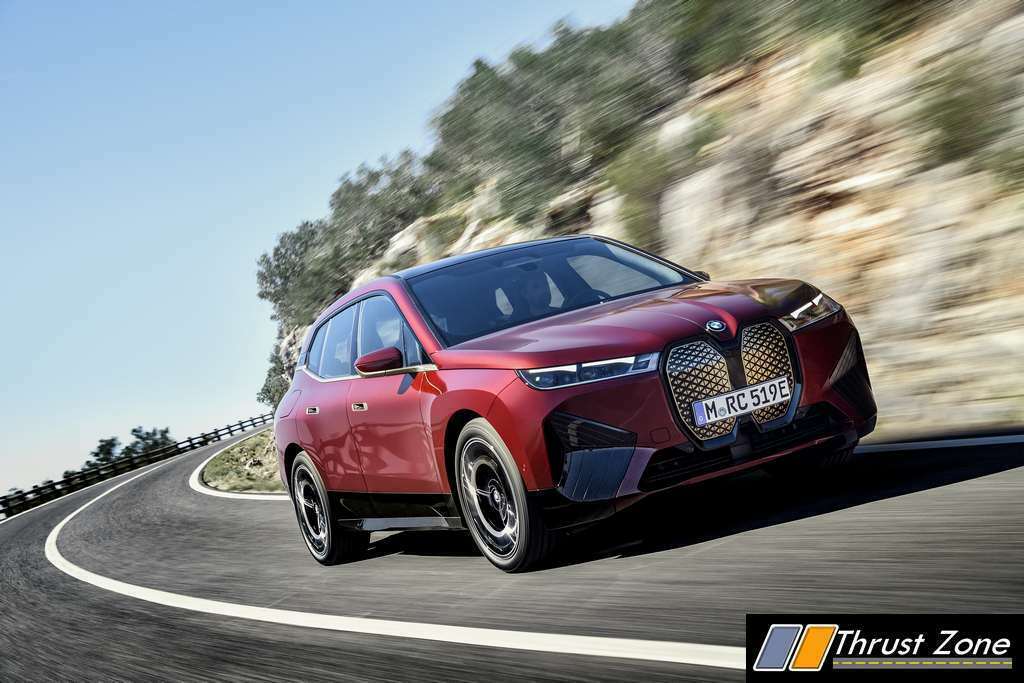Alongside the electrically powered driving pleasure at the driver’s fingertips, sustainability has also been an ever-present element of the BMW i brand character from day one. Making responsible use of resources throughout the value chain and minimising a product’s carbon footprint at all stages of its life cycle underpin the trailblazing approach to premium mobility championed by BMW i. This all-encompassing concept has been implemented more rigorously than ever in the development and production of the new BMW iX – from the monitored selection and extraction of raw materials, through the sourcing of electricity generated from renewable sources for manufacturing processes, to the use of recycled materials.
The resulting carbon footprint is stated in a validation document endorsed by independent auditors. The certificate for the BMW iX xDrive40, for instance, shows its global warming potential is around 45 per cent lower than that of a comparable Sports Activity Vehicle with a combustion engine. In the supply chain alone, utilising green energy for battery production and making increased use of secondary materials cuts CO2 emissions by 17 per cent compared with vehicle production where these measures are not deployed. The powerful impetus provided by the BMW i brand in leading the way in this field has helped the BMW Group to stake a claim as the world’s most successful and sustainable technology company in premium mobility. To achieve this, advances have been made across a wide variety of areas that affect the creation and use of vehicles from all the BMW Group’s brands. Measures for optimising sustainability are defined for every model and cover all phases – from the production of raw materials through manufacturing and use to subsequent recycling.
All New All Electric BMW iX India Launch Price Revealed – A New Benchmark!
The sustainability targets for the BMW iX were set at a very early stage of vehicle development. Defining the appropriate measures requires detailed knowledge of the materials used and where they originate from or how they were obtained. This includes the upstream production chains. The focal points on the purchasing side are compliance with environmental and social standards, respect for human rights, conservation of natural resources and reduction of CO2 emissions. Measures for optimising sustainability were therefore established in consultation with suppliers, such as using recycled materials and harnessing renewable energy. Besides an eco-friendly manufacturing process, consideration is also given here to the recyclability of the component in question and to health-related aspects. The material properties of all components are meticulously documented and verified at the BMW Group’s materials laboratory. The checks also include ensuring that potentially allergenic materials, such as nickel, are not used in areas where they could be touched by customers.
This holistic approach to improving sustainability also embraces those technological developments that make it possible to reduce the use of critical materials, or even avoid them altogether. For instance, a design principle has been devised for the electric motors in fifth-generation BMW eDrive technology that dispenses with the need for rare-earth metals in the rotor. Instead of the customary magnets for which these raw materials are needed, an electrically excited rotor is used to ensure both instantaneous and precisely controllable actuation of the electric drive. The BMW Group has thereby capitalised on its industry-leading development expertise in the field of drive systems to enable it to produce electric motors irrespective of rare earth availability.
During development of the latest generation of battery cells, the proportion of cobalt contained in the cathode material was reduced to less than ten per cent. In addition, the BMW Group procures the cobalt required for this battery cell generation itself and then makes it available to the battery cell suppliers. The company can therefore ensure that environmental and sustainability standards are observed during the extraction and processing of cobalt and that there are no violations of human rights.
Although no cobalt from the Democratic Republic of the Congo (DRC) is being used in the battery cells for fifth-generation BMW eDrive technology, the BMW Group is involved in a pilo project there focusing on ecologically and socially sustainable mining of this raw material. The company, together with its supply chain partners, has commissioned the German Agency for International Cooperation (GIZ) to develop measures aimed at improving working and living conditions for both artisanal mine workers and the inhabitants of nearby communities. If the project is successful, having cobalt supplied directly from the DRC could become an option for the BMW Group once more.
Lithium is another raw material that is vital for the production of high-voltage batteries but classified as critical. The BMW Group again sources this raw material directly before supplying it to battery cell manufacturers. This ensures complete transparency regarding the origin of the raw materials required for lithium-ion batteries. The lithium used in the high-voltage battery pack on board the BMW iX is mined from hard-rock deposits in Australia in accordance with the company’s environmental and sustainability standards. The BMW Group has also commissioned two prestigious American universities to carry out a study into sustainable lithium extraction in Latin America. The aim of the study is to investigate the impact of lithium extraction on local water supplies.
The BMW Group is making a further commitment to wide-reaching sustainability through its involvement in an initiative to protect deep-sea habitats. The move sees the company supporting the activities of the World Wide Fund for Nature (WWF) Germany. In a joint declaration, the BMW Group and companies in other industries have undertaken, as a precautionary measure, not to use deep-ocean minerals or finance deep-sea mining until comprehensive scientific research into the impact of deep-sea mining can be conducted and sufficient protection for deepsea environments can be ensured.
Deep-sea deposits of mineral raw materials have recently received greater public attention due to growing demand for raw materials in general. In particular, manganese nodules (polymetallic nodules), cobalt-rich iron and manganese crusts, as well as massive sulphides and ore sludge, could attract the interest of mining companies. Some experts believe this could offer an attractive alternative to minerals from terrestrial mining. However, the majority remain sceptical overall, due to the lack of scientific analysis. Currently, there are not sufficient scientific findings to be able to assess the environmental risks of deepsea mining, and we are aware that the procurement of raw materials requires particular care. For this reason, the decision has been taken that raw materials from deep-sea mining are not an option for the company at present.
Among other sustainability goals set out by the BMW Group is the increased use of secondary raw materials in vehicle production. Indeed, the company is aiming to significantly increase the proportion of recycled materials it uses by 2030 and to use raw materials multiple times as part of a circular economy approach.
Electricity from renewable resources for component and vehicle manufacture.
Between 2006 and 2019, the BMW Group was able to lower CO2 emissions from vehicle production by over 70 per cent. Compared with 2019 levels, the amount of CO2 per vehicle is set to be reduced by a further 40 per cent by 2025 and 80 per cent by 2030. Since 2020, electricity generated entirely from renewables has been purchased externally for vehicle manufacture at all plants in the BMW Group’s global production network. Only green hydroelectric power produced locally at the lsar and Lech rivers is used in the production of the BMW iX at BMW Group Plant Dingolfing and in the upstream component plants.
The manufacture of battery cells is an energy-intensive process. With a view to also minimising the carbon footprint in this area, the BMW Group has secured commitments from all makers of battery cells for fifth-generation BMW eDrive technology to only use electricity from renewable sources.
In order to further reduce the CO2 emissions arising from the production of aluminium components, the BMW Group is exploring new ways of sourcing this lightweight material. Since February 2021, the company has procured aluminium manufactured in the United Arab Emirates with the help of solar power. Electricity generated in a vast solar park located in the desert outside Dubai is used for producing the lightweight metal. The BMW Group plans to continue sourcing aluminium manufactured with green energy over the long term, enabling it to reduce carbon emissions by 2.5 million tonnes by 2030. The quantities of aluminium acquired using solar power cover nearly half the annual requirements of the light metal foundry at BMW Group Plant Landshut, whose output includes the casings for the latest-generation electric motors fitted in the BMW iX.
Careful material selection, high proportion of recycled materials. Besides the switch to green power, the other factor helping to make the manufacture of light-alloy components more sustainable in the BMW Group’s production network is the ongoing increase in the proportion of secondary aluminium used. Targeted use of recycling methods for this high-grade lightweight metal can lead to a substantial reduction in the energy-intensive use of primary aluminium, which also generates high levels of CO2 emissions when conventional manufacturing techniques are employed. The proportion of secondary aluminium used in manufacturing the castings for the BMW iX is up to 50 per cent.
The cabin of the BMW iX features carefully selected materials which are of high quality and also maximise the sustainability factor.
The key elements here are conservation of resources, energy efficiency in manufacture and suitability for recycling. The use of chrome in the exterior and interior of the BMW iX has been reduced by up to 90 per cent compared with vehicles where similar sustainability-enhancing measures have not been applied. For example, in the interior of the BMW iX, chrome is now only used for selected bolted connections, on the head restraint guides and for the seat belt buckles and guide loops.
The Clear & Bold specification includes a control panel on the centre console made from sustainably grown wood with the corresponding FSC certification. The leather upholstery is also notable for the extremely eco-friendly and material-efficient production method employed. An olive leaf extract is used to treat the leather instead of conventional tanning agents. This is obtained from the leaves gathered following the annual pruning of the trees in European olive groves.
The floor coverings and mats in the BMW iX are made from synthetic yarn that is produced from recycled nylon waste material in a specially developed process. The source material for this includes fishing nets recovered from the sea along with worn flooring and residual waste from plastics manufacturing. These waste products are fed back into the reusable material cycle at a special facility in the Slovenian capital Ljubljana. For this, the material is first broken down into its chemical constituents and then processed to produce nylon granules. The resulting Econyl material forms the basis for making the floor coverings and mats in the BMW iX. As well as helping to preserve resources, the use of Econyl also serves to reduce climate-damaging emissions. The process for manufacturing recycled plastic emits around 80 per cent less CO2 than conventional production of petroleum-based nylon.
High-quality recycled material is also featured in a multitude of other components in the BMW iX. Recycled material accounts for over 20 per cent of the thermoplastic content in the vehicle as a whole. The substructure of the door panelling, the cowl panel cover, the bumper guides and the surround for the front apron, for example, are all made entirely from reused plastic. The cable ducts on the BMW iX are manufactured using between 60 and 100 per cent recycled plastic, while the tailgate panelling and the outer surfaces of the door panelling are both made up of around 30 per cent recycled material. Each BMW iX contains some 60 kilograms of recycled plastic in total.




